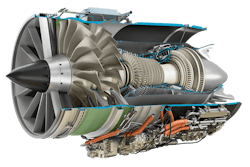GE Says New Private-Jet Engine Answers Need for Supersonic Speed
General Electric Co. has completed its initial design for the first commercial supersonic aircraft engine in five decades, a major hurdle for developing private planes and, perhaps eventually, jetliners that fly faster than the speed of sound.
The twin-shaft, twin-fan design will slash travel times by hours after 50 years in which the average speed of private jets has increased only 10%, GE said on Oct. 15. The engine is being designed for Aerion, a startup backed by Texas billionaire Robert Bass, who has been trying to develop a supersonic business jet for more than a decade.
“Instead of going faster, cabins have increased in size and become more comfortable and range has become longer,’’ said Brad Mottier, GE vice president for business aviation.’’
The engine design bolsters Aerion’s goal of putting a supersonic plane in the sky next decade. Lockheed Martin Corp. is helping with design and production of Aerion’s AS2 plane, which would seat 12. Flexjet, which flies clients who buy fractional ownership of an aircraft, agreed in 2015 to buy 20 of the planes. Aerion is targeting the aircraft’s first flight in 2023, followed by a commercial debut in 2025.
The engine will be able to meet noise and emissions rules while flying faster than the speed of sound over water and decelerating to slower speeds over land. Most countries still ban breaking the sound barrier because of sonic booms. The booms and loud engine noise hobbled flights of the Concorde, contributing to the demise of the last supersonic commercial plane.
Aerion is hardly alone in the race to develop civilian planes that fly faster than the speed of sound. Boom Technology Inc., a Colorado startup, is developing a 45-to-55 seat plane capable of connecting New York and London in about three hours. Virgin Atlantic Airways Ltd. and Japan Airlines Co. have said they intend to purchase the aircraft.
GE is paving the way for non-military aircraft to return to supersonic flight, Aerion CEO Tom Vice said. The AS2 will fly at 1.4 times the speed of sound. If that plane is successful, Aerion is planning other aircraft including a commercial jet, Vice said.
“Our mission is to enhance global mobility with supersonic speed, starting with business aviation, and following with successively faster and larger designs for business and commercial aviation,’’ he said.
The next milestone for the GE engine is in 2020 when it will be ready to begin detailed design and “test-article production,’’ Mottier said.
By Greg Stohr
About the Author
Bloomberg
Licensed content from Bloomberg, copyright 2016.
